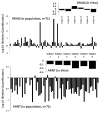Biomarkers linking PCB exposure and obesity
- PMID: 25420728
- PMCID: PMC4292903
- DOI: 10.2174/1389201015666141122203509
Biomarkers linking PCB exposure and obesity
Abstract
Recently the prevalence of obesity has increased dramatically across much of the world. Obesity, as a complex, multifactorial disease, and its health consequences probably result from the interplay of environmental, genetic, and behavioral factors. Several lines of evidence support the theory that obesity is programmed during early development and that environmental exposures can play a key role. We therefore hypothesize that the current epidemic might associated with the influence of chemical exposures upon genetically controlled developmental pathways, leading to metabolic disorders. Some environmental chemicals, such as PCBs and pesticide residues, are widespread in food, drinking water, soil, and they exert multiple effects including estrogenic on cellular processes; some have been shown to affect the development of obesity, insulin resistance, type 2 diabetes, and metabolic syndrome. To bring these lines of evidence together and address an important health problem, this narrative review has been primarily designed to address PCBs exposures that have linked with human disease, obesity in particular, and to assess the effects of PCBs on gene expression in a highlyexposed population. The results strongly suggest that further research into the specific mechanisms of PCBs-associated diseases is warranted.
Conflict of interest statement
The authors confirm that this article content has no conflicts of interest.
Figures




References
-
- World Health Statistics 2013 (WHO) http://www.who.int/mediacentre/factsheets/fs311/en.
-
- Ogden CL, Yanovski SZ, Carroll MD, Flegal KM. The epidemiology of obesity. Gastroenterology. 2007;132(6):2087–2102. - PubMed
Publication types
MeSH terms
Substances
Grants and funding
LinkOut - more resources
Full Text Sources
Other Literature Sources
Medical

